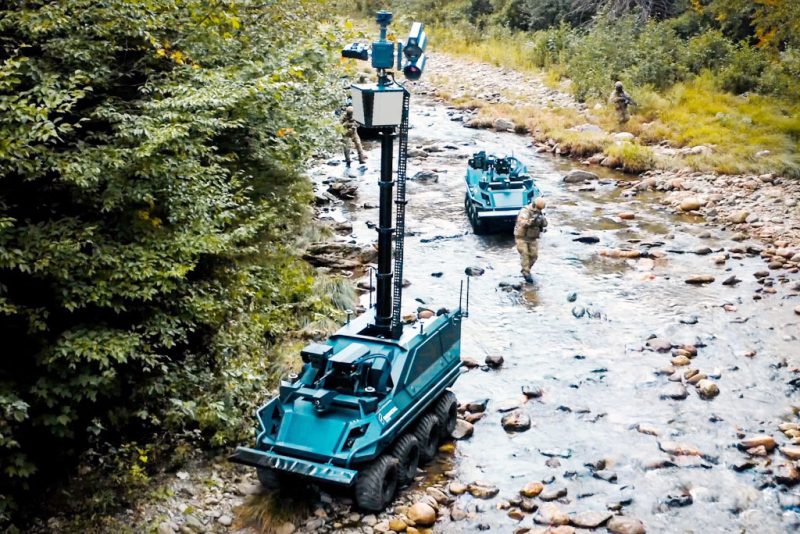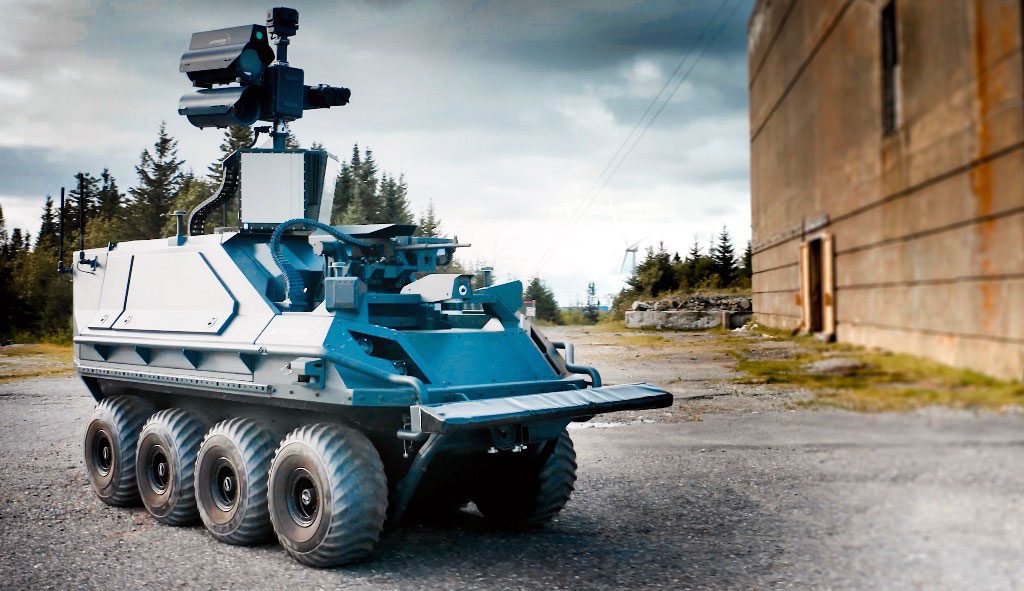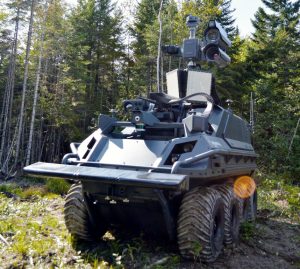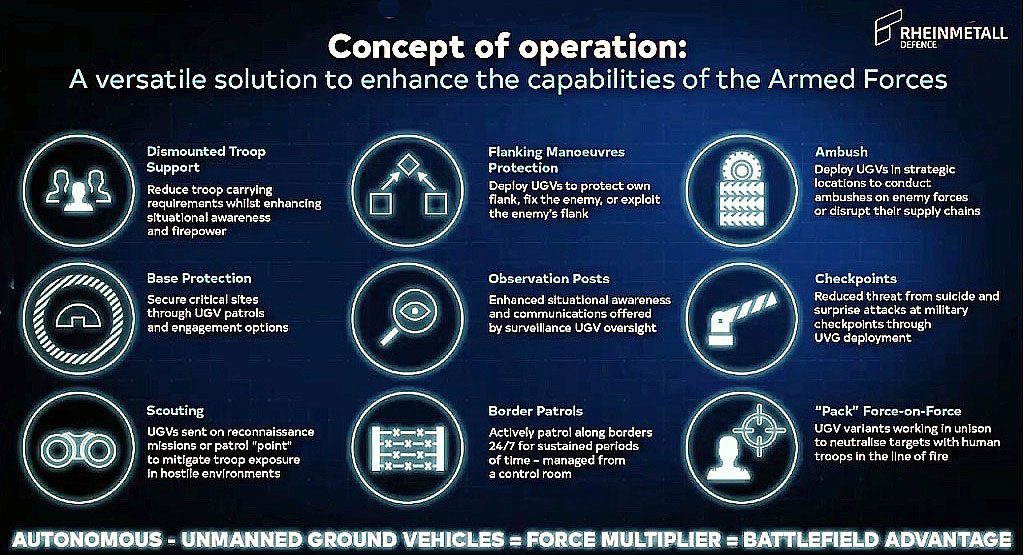
By Paolo Valpolini
The 8×8 autonomous unmanned ground vehicle (A-UGV) developed by Rheinmetall Canada, the Mission Master, has become a reality since some time, however the overseas branch of the Rheinmetall group continues to evolve it, introducing new capabilities and new concepts of operation.
Carrying out reconnaissance missions is definitely one of the risky jobs in the military, as you never know what might hide behind the next corner. Dealing with that mission using an unmanned vehicle might not only save lives but even provide more information: a UGV of the size of the Mission Master, with its 600 kg payload, can carry definitely more sensors than a patrol on foot, be nearly as quiet, as it runs on electric motors, while it is certainly more discrete both visually and thermally than a manned reconnaissance vehicle.

The new module installed on top of the well known 8×8 Argo all-terrain vehicle chassis is fitted at the front with a Rheinmetall Fieldranger remotely-controlled weapon station, armed with a 7.62 mm machine gun, which can fire on the 180° frontal arc, the back of the module being raised to contain all the mission electronics as well as the space to host the sensors head that can be elevated up to 3.5 meters height using a telescopic mast; to allow the Mission Master Armed Reconnaissance to fit into transport helicopters such as the CH-47 or the CH-53, by the way the two models that were bidding for the German STH (Schwerer TransportHubschrauber) contract that soon or late will have to surface again, the sensor system tilts backwards ensuring the A-UGV fits into the cargo area of those aircraft.

Sensors installed were picked up by Rheinmetall Canada for development purposes, however the company is ready to integrate different systems depending on customers’ requirements; to give an idea of the type of sensors considered, on the front of the mast, in a low position, two flat ground surveillance radar antennas ensure the coverage of a 180° sector, while on the left side, higher than the radar, we find the day camera with a 1,000×1,000 pixels CCD sensor and a zoom lens that provides a horizontal Field of View (FoV) from 20° to 2.2°, the night sensor being a thermal MWIR camera based on a 640×452 cooled focal plane array, the zoom providing a wide FoV of 9.15° and a narrow FoV of 2.75°. The third element, positioned on top of the other two, is the Laser RangeFinder, which has a maximum range of 10 km. On the right side we find a laser designator; this can illuminate targets in favour of laser-guided rockets, missiles or bombs, considerably increasing the lethality provided by the automatic weapon installed on the Mission Master Armed Reconnaissance. On top of the mast a further camera provides a 360° panoramic view. This is the top suite developed by the company to integrate as many sensors and effectors possible, but it is obviously scalable, depending on customer’s needs and budget.

The autonomy core is the Rheinmetall PATH autonomous kit (A-kit), designed to enable military vehicles to operate in unmanned mode. As far as the autonomous navigation and driving is concerned, “Our system complies with SAE Level 4 standards,” Alain Tremblay, Vice-President, Business Development at Rheinmetall Canada tells EDR On-Line, maximum speed admitted on civilian roads being 30 km/h. In that function the PATH is considered at TRL 8, the same applying to reconnaissance functions: “Once given a surveillance area, the system will drive there autonomously, will perform its mission, and will automatically send an alert should something happen in its sector of interest,” Tremblay explains. Artificial Intelligence is used in both areas; in navigation, among other functions, it helps to determine the type of obstacle, i.e. mud, rock, bush, autonomously adapting the vehicle behaviour to overcome it. As for reconnaissance, AI is used to typify and possibly identify potential targets, in order to ease the burden of the operator back at the control station, sending in only those that might represent a threat. In both cases AI contributes to increase the A-UGV “experience”, self-learning algorithms allowing to improve its autonomy after each mission. become different when considering the kinetic element: “Here we are at TRL-6, closing to TRL-7,” Alain Tremblay tells us. Although many functions are autonomous, such as target acquisition and locking, when firing missions are involved most countries will never allow the engagement decision to be devoted to a fully autonomous system, a human being in the end the responsible for firing. The usual way is to have the man-in-the-loop, who supervises all the steps leading to the engagement; a higher-end level is the man-on-the-loop, in which the machine acts autonomously, searching, detecting and tracking the target, passing it over to the human being and awaiting his green light before opening fire. While the lower-level option is fully available, Rheinmetall Canada is currently working to further develop and improve this second engagement mode. For the Armed Reconnaissance variant Rheinmetall Canada has developed a specific tablet that incorporates a safety board, in order to meet all safety and security standards required by NATO when a weapon system is involved. Communications with the HQ are provided by a bi-directional communication system, which can also link together more A-UGVs to exchange information on the tactical scenario. When the soldier needs to interface with the Mission Master various means are available, ranging from the aforementioned tablet, to a smartwatch, to the soldier system MPA, to a single-hand controller. All those allow the soldier on the ground to access the PATH menu and select advanced features and operational modes, the Mission Master being fitted i.e. with follow-me and convoy modes beside the aforementioned autonomous navigation one. Each mode incorporates multiple layers of protection to ensure that the vehicle operates safely at all times.

An issue that was raised during the briefing was endurance, as a reconnaissance asset must be able to remain on the field for some time, to ensure persistent surveillance, and possibly also be able to travel some distance. “Based solely on its Li-Ion battery pack the Mission Master is capable to travel for 8 hours at two-thirds of its maximum speed, covering around 140-160 km, depending on the terrain,” Tremblay says, underlining that an Auxiliary Power Unit (APU) might be installed to considerably increase the range, although this will of course increase thermal and acoustic signatures. Such a solution might have to be adopted when operating in cold areas, temperatures below –30° deeply affecting battery performances, while no problems were encountered during high temperatures tests. According to Tremblay, a retired Canadian Army Major General, the 8 hours continuous operation is unrealistic, “And during tests in the United Kingdom and in the Netherlands the vehicle batteries had to be recharged only after 24-30 hours.”
During the briefing Mr. Tremblay provided numerous other information on further developments in the robotic field. “In Q3 2021 we plan to demonstrate live the capacity of our system to operate with multiple A-UGVs with a single operator,” he says, detailing that currently one man can control from two to six Mission Masters. Known under the name Wolf Pack, this multiple control capacity allows deploying a team of unmanned systems supporting each other; these can be of course fitted with different modules to provide a series of capabilities, while employing minimal manpower. In essence, the operator works as a task manager, A-UGVs carrying out the mission they were assigned in full autonomy, except in the case of firing. “We are looking to further expand the concept,” Tremblay said, “Our aim being that of deploying a few dozen Mission Masters from a command post operated by only two-three people.” The link can be ensured by different means, ranging from LTE (Long Term Evolution) networks, to SATCOM, to military cloud.

Another novelty forecasted for 2021 is the adoption of a new platform, which will further increase cross-country performances and will provide better amphibious capabilities, as the current Mission Master is amphibious but not with the full payload. The new automotive base will fitted with the same autonomy kits used on the Mission Master, and Rheinmetall plans to unveil the new A-UGV in Q2 2021. Leveraging the work done on the Mission Master, Rheinmetall Australia is fitting a Wiesel light tracked vehicle with autonomy modules for carrying out tests on manned-unmanned teaming as required by the Australian military, that nation being involved in a similar programme in the air, known as Loyal Wingman. Some work on autonomous Wiesel was already carried out in Kiel some years ago. Moreover in Germany Rheinmetall Land Systems is also adding autonomous capabilities to heavy logistic trucks, to verify how much those might help in reducing the risks and the manpower footprint in downrange missions.
According to Alain Tremblay the Mission Master is being evaluated in numerous countries against other UGVs of the same category and is performing well. Last week the Rheinmetall canada A-UGV was part of a robotic experiment carried out by the Italian Army.
Rheinmetall: autonomous armed reconnaissance duties for Mission Master A-UGV - EDR Magazine
By Paolo Valpolini The 8×8 autonomous unmanned ground vehicle (A-UGV) developed by Rheinmetall Canada, the Mission Master, has become a


